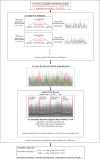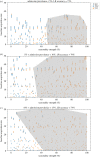Deconstructing the effects of stochasticity on transmission of hospital-acquired infections in ICUs
- PMID: 37711144
- PMCID: PMC10498044
- DOI: 10.1098/rsos.230277
Deconstructing the effects of stochasticity on transmission of hospital-acquired infections in ICUs
Abstract
The inherent stochasticity in transmission of hospital-acquired infections (HAIs) has complicated our understanding of transmission pathways. It is particularly difficult to detect the impact of changes in the environment on acquisition rate due to stochasticity. In this study, we investigated the impact of uncertainty (epistemic and aleatory) on nosocomial transmission of HAIs by evaluating the effects of stochasticity on the detectability of seasonality of admission prevalence. For doing so, we developed an agent-based model of an ICU and simulated the acquisition of HAIs considering the uncertainties in the behaviour of the healthcare workers (HCWs) and transmission of pathogens between patients, HCWs, and the environment. Our results show that stochasticity in HAI transmission weakens our ability to detect the effects of a change, such as seasonality patterns, on acquisition rate, particularly when transmission is a low-probability event. In addition, our findings demonstrate that data compilation can address this issue, while the amount of required data depends on the size of the said change and the degree of uncertainty. Our methodology can be used as a framework to assess the impact of interventions and provide decision-makers with insight about the minimum required size and target of interventions in a healthcare facility.
Keywords: agent-based modelling; hospital-acquired infection; intervention; seasonality; simulation.
© 2023 The Authors.
Conflict of interest statement
We declare we have no competing interests.
Figures








References
-
- Wu J, Jones KB, Li H, Loucks OL. In press. Scaling and uncertainty analysis in ecology: methods and applications.
-
- Coleman HW, Steele WG. 2018. Experimentation, validation, and uncertainty analysis for engineers. Hoboken, NJ: John Wiley & Sons, Ltd.
Associated data
Grants and funding
LinkOut - more resources
Full Text Sources

